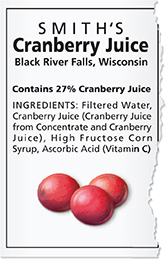Concentration of Solutions
How do you take your tea? Some people prefer their tea very concentrated, so they leave the tea bag in hot water for several minutes. Other people immerse the tea bag for only a minute or two, because they prefer their tea much less concentrated, or dilute. The resulting solutions differ in how much solute is present. The concentration of a solution is the amount of solute dissolved in a specified amount of solution.  Concentration can be expressed as percent by volume, percent by mass, and molarity.
Concentration can be expressed as percent by volume, percent by mass, and molarity.
Figure 12 The juice squeezed from fruit is already a solution. Most bottled or canned juices are less-concentrated solutions of fruit juices, made by adding water. Percent by volume is a way to measure the concentration of one liquid dissolved in another.
 d
dPercent by Volume
Fruit juice bottles often have labels, such as the one in Figure 12, that state the percentage of “real juice” in the bottle. For example, if 27 percent of the total volume of liquid is fruit juice, the concentration of fruit juice is 27 percent by volume. Use the following equation to calculate concentration as a percent by volume.
Percent by Mass
Concentration expressed as a percent by mass is more useful when the solute is a solid. Percent by mass is the percent of a solution's total mass that is accounted for by a solute.
Suppose you have 100 grams of a solution of sugar in water. After allowing the water to evaporate, 15 grams of sugar remain. So, the concentration of sugar in the solution was 15 percent by mass.
Problem-Solving Activity 
Putting the Fizz Into Carbonated Beverages
You have been asked to find a supplier of carbon dioxide for a factory that produces carbonated beverages. You also must find out how to regulate the carbonation levels of the beverages produced.
Defining the Problem Describe your task in your own words.
Organizing Information Find examples of chemical reactions that produce carbon dioxide. What industries use such reactions? In addition, list and review the general factors affecting solubility.
Creating a Solution Choose a business or industry to supply your factory with carbon dioxide. Figure out how the solubility of a gas in a liquid varies under different conditions.
Presenting Your Plan
Write a proposal to the manager of your factory. Explain your choice of a carbon dioxide supplier, and describe how to regulate carbonation levels of the beverages produced.




